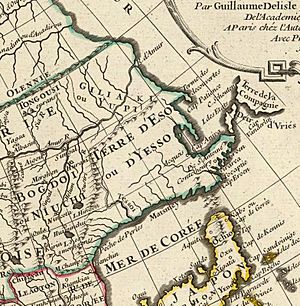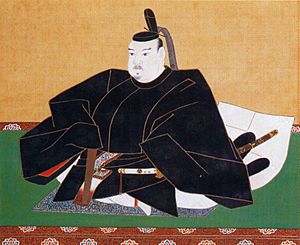Maarten Gerritszoon Vries facts for kids

Maarten Gerritszoon Vries, also known as de Vries, was a Dutch explorer and mapmaker. He was born in Harlingen, Netherlands in 1589. He died at sea near Manila in late 1647. He was the first Western European to write about visiting Ezo (now Hokkaidō), Sakhalin, the Kuril Islands, and the Sea of Okhotsk.
Not much is known about de Vries's early life. He spent many years in Taiwan. He is best known for his journey in 1643. He explored the north-western Pacific Ocean. His goal was to find the coast of Tartaria. This trip was ordered by Anthony van Diemen, the governor in Batavia. It was the second trip to search for legendary gold and silver islands in the Pacific. The first trip in 1639, led by Matthijs Quast, did not find them.
Contents
De Vries's Amazing Expedition
In February 1643, two ships began their journey from Batavia. Batavia was the capital of Dutch Java. The ships were the Castricum, led by De Vries, and the Breskens, led by Hendrick Cornelisz Schaep.
After stopping in Ternate in the Moluccas, they continued on April 4. On May 20, a storm caused the two ships to lose sight of each other. This happened near Hachijō-jima, an island south of Edo (now Tokyo). The Dutch named this island Ongeluckich, meaning "Unlucky," because of the storm.

The Breskens Visits Yamada
The ship Breskens found a good bay and was welcomed by the people of Yamada. Yamada is in the Tohoku area of Japan. Six weeks later, the Breskens returned to Yamada.
One evening, the crew had a party with a samurai and some Japanese women. The next day, July 29, ten crew members were invited to a farm. They were promised fresh food. The unarmed crew was given sake and rice. But then, they were captured. They were sent to Morioka and Edo for questioning.
The Japanese leaders, called the bakufu, were worried. They feared that Portuguese or Spanish Jesuits (Catholic priests) had landed. They were very concerned about protecting their coasts. However, they soon understood that the crew were Dutch merchants, not Catholics. The problem then became how to release the Dutch crew safely.
After Jan van Elserac arrived, the shōgun Tokugawa Iemitsu sent the crew to Deshima in December. The crew had to wait nine months for the next ship to Taiwan. Meanwhile, the Breskens had already left Honshu at the end of July. It sailed without its captain, searching for the Gold and Silver Islands.
The Castricum Sails North
In the summer of 1643, the Castricum sailed past the southern Kuril Islands. They visited Kunashir and Iturup. They named Iturup "Staten Island." They also visited Urup, which they called "Company Island." They claimed Urup for the Netherlands. On Urup, they met the Ainu.
The Castricum sailed between Iturup and Urup. This passage was later named Vries Strait after Maarten Gerritszoon Vries. After passing through the strait, they entered the Sea of Okhotsk.
The Dutch ship sailed north but did not find any land. Then, strong winds pushed them southwest toward the northern shores of Hokkaidō. They then sailed north again. They visited Cape Aniva (the southeastern tip of Sakhalin Island). They also explored the Gulf of Patience and Cape Patience. At these places, they met the local Ainu people. They communicated with them using sign language.
After another trip into the Pacific, the Castricum returned to Japanese waters. It met the Breskens off Kyūshū. The two ships then sailed to Fort Zeelandia (Taiwan). They returned to Batavia in mid-December 1643.
Maarten Gerritsz Vries later died from disease while at sea.
See also
 In Spanish: Maarten Gerritsz Vries para niños
In Spanish: Maarten Gerritsz Vries para niños


